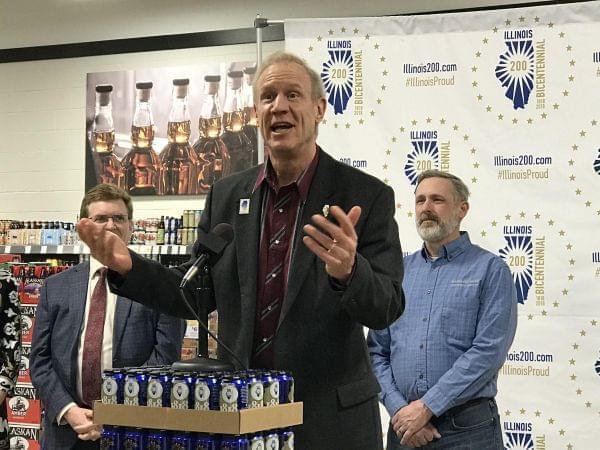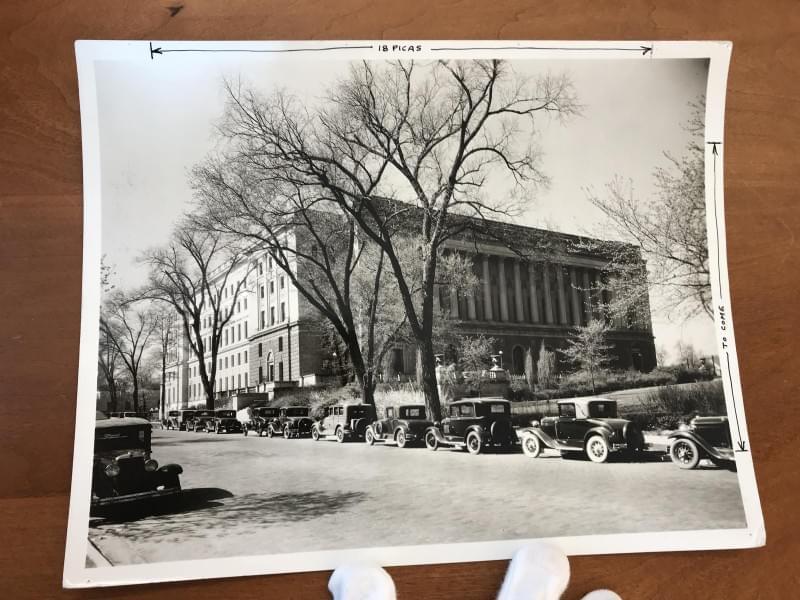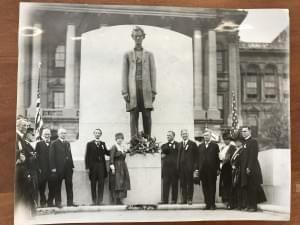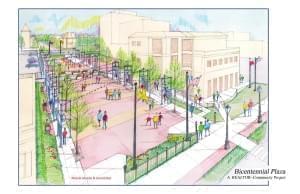Illinois Issues: What’s On Tap For The State’s Big Birthday Party?

Gov. Bruce Rauner addresses the public at Binny's Beverage Depot in Springfield on March 14 at the unveiling of the official Bicentennial beer cans. Mary Cullen/NPR Illinois
Illinois will celebrate its 200th birthday with statewide events, building projects, specialty Pepsi cans, stamps, rosé, apparel and even an officials brew, "1818 Prairie State Farmhouse Ale."
For this anniversary, no major building will be constructed. Instead, renovations of the Executive Mansion, budgeted at $15 million, are to be completed, and construction of a Bicentennial Plaza adjacent to the mansion is under way. Both projects are privately funded, except for $1 million for the plaza coming from City of Springfield tax increment financing funds.
Legacies from Illinois’ past birthdays have taken a different route with permanent structures to commemorate the occasion.
In 1918, the people of Springfield voted to give $100,000 to the construction of the Centennial Building. The project, considered the most long-lasting physical legacy of the Centennial, cost $3 million after its completion in 1923. Today, that would run the state just over $53 million.

The Centennial building, now the Howlett Secretary of State Facility, began construction on October 5, 1918, and was completed in 1923. (Photo provided by the Abraham Lincoln Presidential Library and Museum.)
In 1868, the construction of the current Capitol building began. In 1918, the cornerstone was laid for the Centennial building, now the Howlett Secretary of State Facility. For the sesquicentennial in 1968, the Old State Capitol was rebuilt.
Each project was funded by the state.
In addition to the two smaller-scale contemporary building projects, the Illinois Bicentennial Commission adopted a resolution this month to install two new statues of a pair of world famous politicians on the capitol grounds: former presidents Ronald Reagan and Barack Obama.

The statues of Abraham Lincoln and Stephen Douglas were unveiled as part of the Centennial celebration on October 5, 1918. (Photo provided by the Abraham Lincoln Presidential Library and Museum's Lincoln Collection)
This mirrors the centennial celebration in 1918 when the statues of Abraham Lincoln and his longtime political rival Stephen Douglas statues were unveiled. But, that’s where the similarities end.
“Given the budgetary climate currently in Illinois, I believe it would be difficult, if not impossible, to approve state funds to pay for these statues,” said state Rep. Tim Butler, a Springfield Republican and member of the Bicentennial Commission.
While the people of Illinois paid about $75,000 to construct the Lincoln and Douglas likenesses, the Bicentennial Commission is counting on charity to cover the cost for the new ones. And, while officials celebrated unveiling the statues in 1918, the most that can be hoped for the new additions is solidifying plans in 2018 with an unveiling in 2021.
“We're not rich, but we'll make do,” said Stuart Layne, executive director of the Bicentennial Commission. “You know, with a small budget, we can't go around the state and build things. But here in Springfield in particular I think there will be real signs of lasting legacies.”
The commission had no budget other than whatever funds were raised from sponsors and donors. Layne, however, has been paid from various departments totaling $207,083 since his appointment in late 2016.
“Whether it's a stamp, or a shirt, or a bicentennial Pepsi can, people love to have keepsakes. So, we're providing enough of those, I think, that will keep people happy,” Layne said.
And so, enter the beer. A saison by Hand of Fate brewery in Petersburg won the statewide contest to brew the commemorative Bicentennial beer.
“The idea came from us sitting around wondering how we were going to reach millennials who have a device in their face and probably don’t care too much about history,” Layne said. "So, we said, ‘Well, let’s put a beer in their hands.’”
There were grander visions a century ago.
In an editorial by the Chicago Examiner, there was a call for Illinoisans to celebrate the state’s next 100 years by building on the traditions from its first. “The holding of the centennial celebrations next year should be on a scale worthy of the history of Illinois and its manifest destiny. . . And there is timeliness in the suggestion that the Centennial should not pass without permanent memorials.”
Despite the struggles of life in the early 20th century including World War I and the spread of the flu epidemic, Illinoisans had the desire to celebrate their state for all its glory with those permanent structures.
“We were involved in a world war at that time, and it was a very unpopular war, and people forget that. . . . The Centennial was used as a way to increase patriotism, not only for Illinois but for the country as well,” David Joens, director of the Illinois State Archives said.
James Cornelius, curator of the Lincoln Collection at the Abraham Lincoln Presidential Library and Museum, said this shift is all part of our changing economy.

The Bicentennial Plaza, currently under construction for an opening later this year, will create a walkway from the Lincoln home to the newly renovated Executive Mansion.
“In Illinois, as in every other state in the union, manufacturing is a smaller part of what we do now than we did 100 years ago, in terms of people employed,” Cornelius said.
With companies learning the most efficient way to do business is through contracting, state government picked up similar habits that are displayed through the privatized Bicentennial projects. The Bicentennial Commission has had little public funding to support its efforts, but that hasn’t been the biggest challenge, Layne said.
“I think our biggest challenge is that we had a short lead time to prepare,” Layne said. “We would have liked a little more time, but it is what it is and I'm so encouraged by the number of people that want to participate that are real history buffs that have real ties to their ancestors and agriculture and the birth of the state.”
Gov. Bruce Rauner did not appoint Layne to direct the Bicentennial until late 2016, leaving only a year of planning before the Bicentennial celebrations began on Illinois’ 99th birthday.
Indiana began planning four years before the 2016 bicentennial with a commission appointed by then-Gov. Mitch Daniels. Both private and public dollars were used, including funds made available by the Indiana state legislature. In addition to hundreds of celebrations there were at least four building projects totaling over $55 million.

According to a recent poll by the Paul Simon Public Policy Institute, state pride could be hard to come by in 2018. When surveying 1,001 voters, 84 percent reported that they thought Illinois was heading in the wrong direction. Still, commission members like Marilyn Kushak are committed to making residents “fall in love with Illinois” again.
Illinois Issues is in-depth reporting and analysis that takes you beyond the headlines to provide a deeper understanding of our state. Illinois Issues is produced by NPR Illinois in Springfield.
Links
- Illinois Issues: On Y-Block Plans, Governor At Odds With Local Businesses
- Illinois Issues: Is Illinois Ready For A Retail Shift?
- Illinois Issues: Money And The Legal Weed Debate
- Illinois Issues: Madigan’s #MeToo Problem
- Illinois Issues: Fight Or Flight — Attorney General Candidates On Impasse Politics
- Illinois Issues: Illinois’ Storied History Of Choosing Its Second-In-Command
- Illinois Issues: Women Rising - The Push For Gender Parity In State Government
- Illinois Issues: Rauner Budget Doesn’t Use ‘Pixie Dust,’ But It’s Fanciful Nonetheless
- Illinois Issues: A Call For Immunization
- Illinois Issues: The Radium Girls - Cleaning Up Contamination
- Illinois Issues: The Radium Girls - An Illinois Tragedy
- Illinois Issues: A Prescription For Fruits And Veggies
